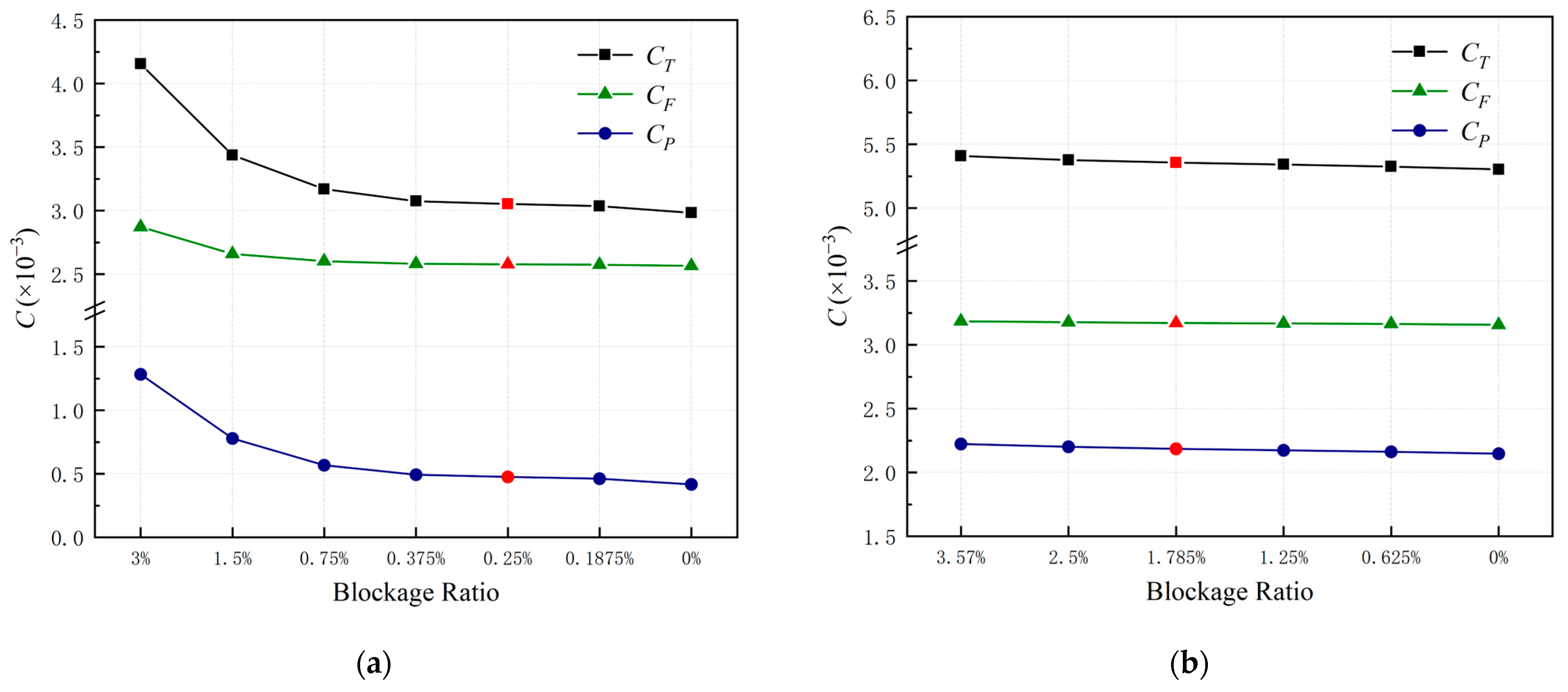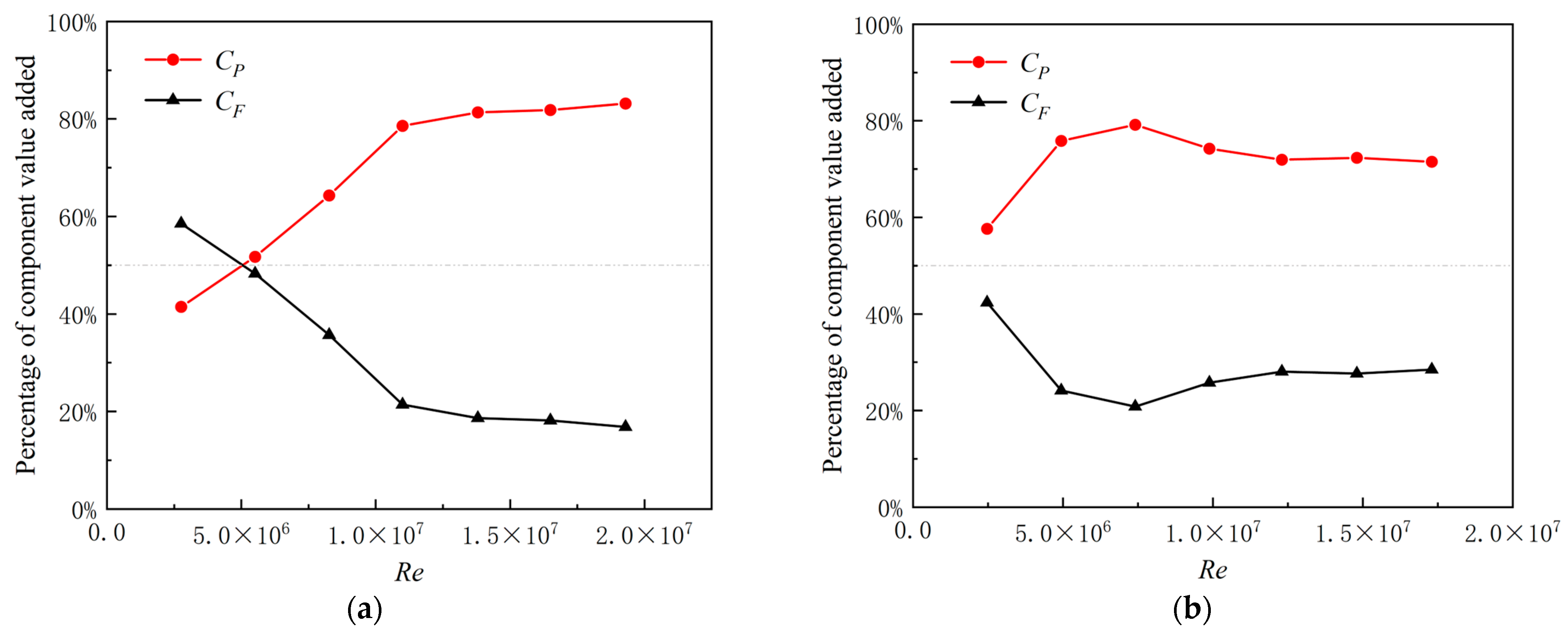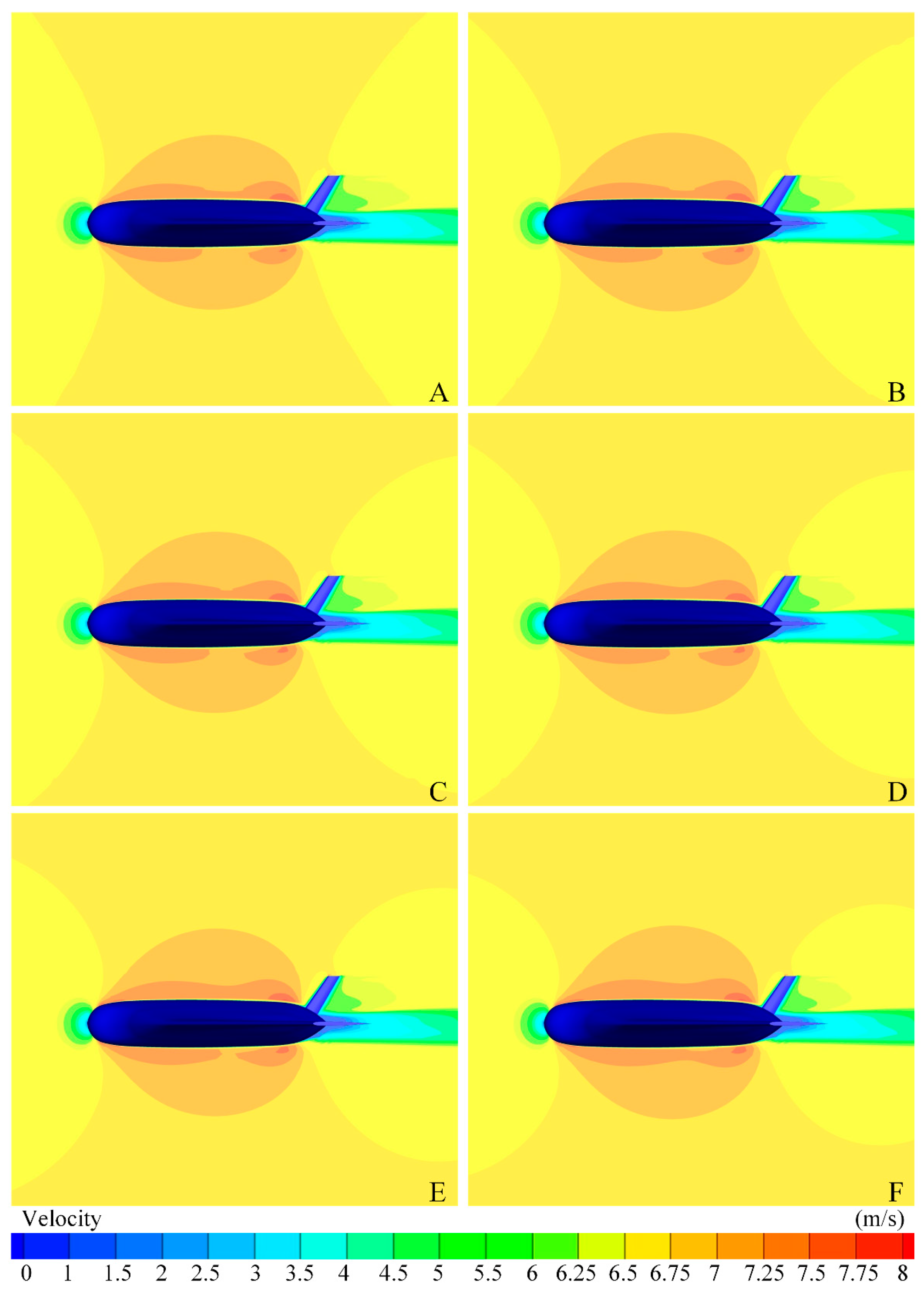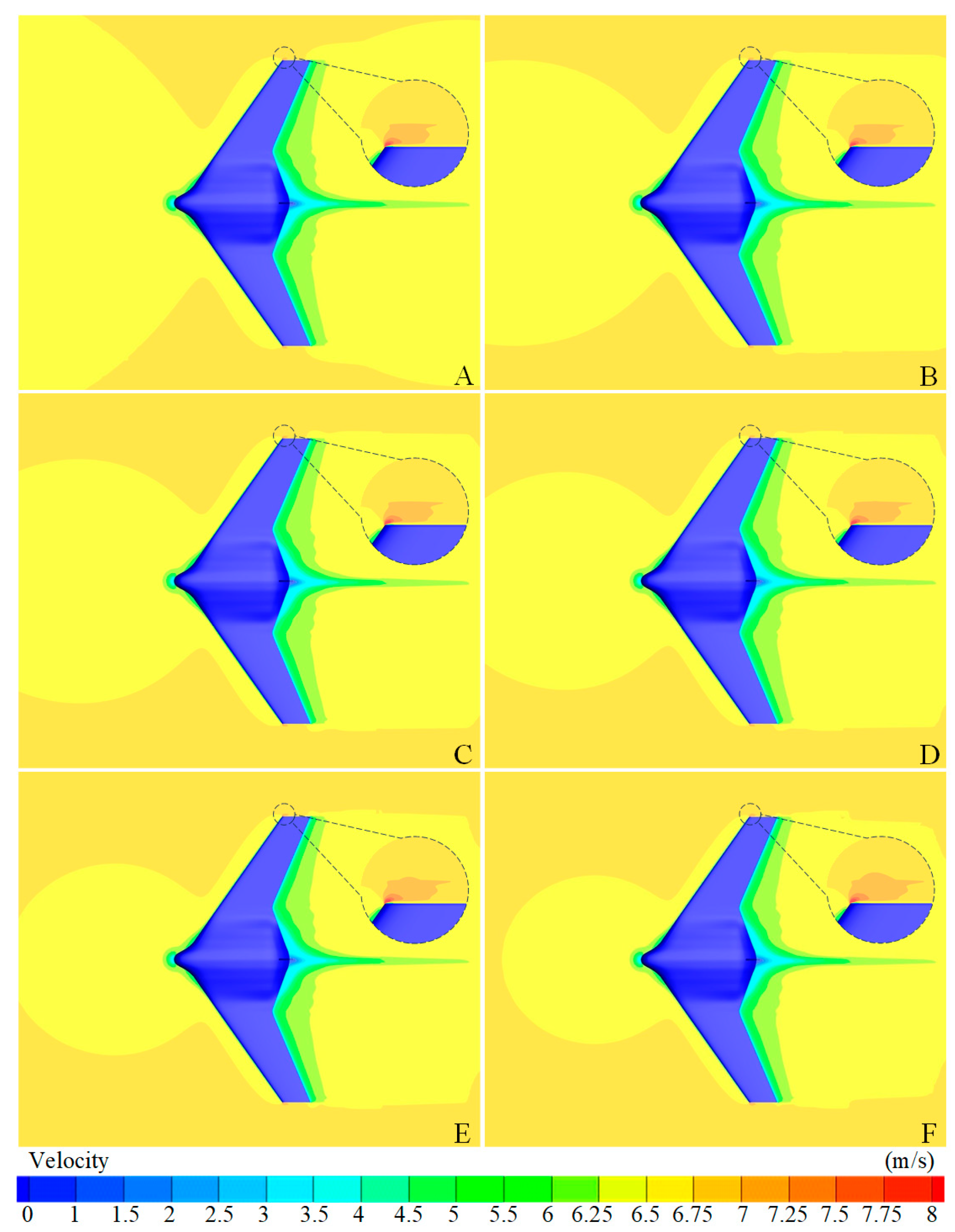The Blockage Effect on Resistance Coefficients Estimation for AUVs with Different Configurations in the Towing Tank
Abstract
:1. Introduction
2. Materials and Methods
2.1. AUV Models
2.2. Numerical Method
2.3. Calculation Domain and Boundary Conditions
2.4. Grid Independence
3. Validation of Numerical Method
4. Results and Discussion
4.1. Resistance Component Analysis
4.2. Velocity Analysis
4.3. Surface Pressure Analysis
5. Conclusions
- The blockage effect of the towing tank wall mainly acts on the pressure resistance for ARBUV and BWBUV. However, the contribution of the pressure resistance component to the total resistance is smaller than that of the friction resistance.
- Compared to the ARBUV, the BWBUV exhibits significantly less susceptibility to blockage effects. It advises to utilize towing tanks with a smaller blockage ratio in practical towing tank experiments. If necessary, the correction may be required for the resistance results for the ARBUV model. It suggests that the blockage ratio of ARBUV should be smaller than 0.375% in the NWPU towing tank test.
- It can also yield accurate resistance results in a towing tank for BWBUG models, even the tank width is slightly larger than the wingspan of the model. The blockage ratio of BWBUV should be smaller than 2.5% in the NWPU towing tank test.
Author Contributions
Funding
Institutional Review Board Statement
Informed Consent Statement
Data Availability Statement
Acknowledgments
Conflicts of Interest
Nomenclature
| Latin symbols | |
| Wa | Width of the AUV |
| Wb | Width of the towing tank |
| Wc | Width of the domain |
| Ha | Height of the AUV |
| Hc | Height of the domain |
| Ht | Width of the towing tank |
| BR | Blockage ratio |
| La | lengths of the AUV |
| Lc | Characteristic length |
| Sa | Wetted surface area |
| ▽a | Displacement volume |
| Time-averaged velocity component | |
| Turbulent pulsating velocity component | |
| External volumetric force | |
| Time-averaged pressure | |
| Gk, Gb | Turbulent kinetic energy |
| YM | Dissipation of Turbulent Kinetic Energy Due to Pressure Strain |
| Sk, Sε | Turbulent Source Term |
| C1ε, C3ε, C1, C2 | Empirical constants |
| CT | Total resistance coefficient |
| CF | Frictional resistance coefficient |
| CP | Pressure resistance coefficient |
| Greek symbols | |
| ρ | Density |
| ν | Kinematic viscosity |
| σk, σε | Turbulent Kinetic Energy Prandtl Number |
| μ | Dynamic Viscosity |
| k | Turbulent Kinetic Energy |
| ε | Turbulent Dissipation Rate |
| Abbreviations | |
| CFD | Computational Fluid Dynamics |
| RANS | Reynolds Averaged Navier-Stokes |
| AUV | Autonomous Underwater Vehicle |
| ARBUV | Axisymmetrical Rotary Body Underwater Vehicle |
| BWBUV | Blended Wing Body Underwater Vehicle |
| Re | Reynolds number |
References
- Yu, P.; Wang, T.; Zhou, H.; Shen, C. Dynamic modeling and three-dimensional motion simulation of a disk type underwater glider. Int. J. Nav. Archit. Ocean Eng. 2018, 10, 318–328. [Google Scholar] [CrossRef]
- Yang, H.; Gao, X.; Li, B.; Xiao, B.; Huang, H. Development of hydroacoustic localization algorithms for AUV based on the error-corrected wmchan-taylor algorithm. J. Mar. Sci. Eng. 2024, 12, 974. [Google Scholar] [CrossRef]
- Ye, P.; Pan, G. Shape optimization of a blended-wing-body underwater glider using surrogate-based global optimization method IESGO-HSR. Sci. Prog. 2020, 103, 1–21. [Google Scholar] [CrossRef] [PubMed]
- Cardenas, P.; De Barros, E.A. Estimation of AUV hydrodynamic coefficients using analytical and system identification approaches. IEEE J. Ocean. Eng. 2019, 45, 1157–1176. [Google Scholar] [CrossRef]
- Liu, X.; Yuan, X.; Luo, K.; Wang, Y. Blockage effect of a wall on the hydrodynamic characteristics of a supercavitating vehicle's aft body. Ocean Eng. 2022, 256, 111564. [Google Scholar] [CrossRef]
- Ji, D.; Wang, R.; Zhai, Y.; Gu, H. Dynamic modeling of quadrotor AUV using a novel CFD simulation. Ocean Eng. 2021, 237, 109651. [Google Scholar] [CrossRef]
- Dantas, J.L.D.; De Barros, E.A. Numerical analysis of control surface effects on AUV manoeuvrability. Appl. Ocean Res. 2013, 42, 168–181. [Google Scholar] [CrossRef]
- Luo, W.; Ma, C.; Jiang, D.; Zhang, T.; Wu, T. The hydrodynamic interaction between an AUV and submarine during the recovery process. J. Mar. Sci. Eng. 2023, 11, 1789. [Google Scholar] [CrossRef]
- Kornilov, V.I.; Popkov, A.N. Blockage effect induced by an airfoil model in the low-velocity wind tunnel test section. Thermophys. Aeromechanics 2020, 27, 359–369. [Google Scholar] [CrossRef]
- Zaghi, S.; Muscari, R.; Di Mascio, A. Assessment of blockage effects in wind tunnel testing of wind turbines. J. Wind Eng. Ind. Aerodyn. 2016, 154, 1–9. [Google Scholar] [CrossRef]
- Eltayesh, A.; Hanna, M.B.; Castellani, F.; Huzayyin, A.S.; El-Batsh, H.M.; Burlando, M.; Becchetti, M. Effect of wind tunnel blockage on the performance of a horizontal axis wind turbine with different blade number. Energies 2019, 12, 1988. [Google Scholar] [CrossRef]
- Sakamoto, N.; Ohashi, K.; Kobayashi, H.; Hino, T. Overset RaNS simulations and validations for the effect of false bottom to the KCS under static drift and static rudder in shallow water. J. Mar. Sci. Technol. 2023, 28, 248–269. [Google Scholar] [CrossRef]
- Jachowski, J. Assessment of ship squat in shallow water using CFD. Arch. Civ. Mech. Eng. 2008, 8, 27–36. [Google Scholar] [CrossRef]
- Kumar, M.; Subramanian, V.A. Numerical and experimental study on tank wall influences in drag estimation. Ocean Eng. 2007, 34, 192–205. [Google Scholar] [CrossRef]
- Zhang, Z.; Deng, H.; Wang, C. Analytical models of hydrodynamic pressure field causing by a moving ship in restricted waterways. Ocean Eng. 2015, 108, 563–570. [Google Scholar] [CrossRef]
- Guo, C.; Xu, P.; Wang, C.; Kan, Z. Numerical and experimental study of blockage effect correction method in towing tank. China Ocean Eng. 2019, 33, 522–536. [Google Scholar] [CrossRef]
- Bottner, C.; Anschau, P.; Shevchuk, I. Analysis of the flow conditions between the bottoms of the ship and of the waterway. Ocean Eng. 2020, 199, 107012. [Google Scholar] [CrossRef]
- Li, L.; Qin, H.; Li, P.; Wang, X. Influence of the blocking effect of circulating water channels on hydrodynamic coefficient estimation for autonomous underwater vehicles. J. Mar. Sci. Appl. 2023, 22, 411–420. [Google Scholar] [CrossRef]
- Huang, H.; Zhou, Z.; Li, H.; Zhou, H.; Xu, Y. The effects of the circulating water tunnel wall and support struts on hydrodynamic coefficients estimation for autonomous underwater vehicles. Int. J. Nav. Archit. Ocean Eng. 2020, 12, 1–10. [Google Scholar] [CrossRef]
- Da Silva, F.D.; Tancredi, T.P.; Silva, E. Corrections for the drag on submarines due to the blockage effect. Ocean Eng. 2023, 275, 114150. [Google Scholar] [CrossRef]
- Du, X.; Liu, X.; Song, Y. Analysis of the steady-stream active flow control for the blended-winged-body underwater glider. J. Mar. Sci. Eng. 2023, 11, 1344. [Google Scholar] [CrossRef]
- Jiang, Y.; Jeong, S.W.; Ahn, B.K.; Kim, H.T.; Jung, Y.R. Experimental investigation of drag characteristics of ventilated supercavitating vehicles with different body shapes. Phys. Fluids 2019, 31, 052106. [Google Scholar] [CrossRef]
- Guo, C.; Wang, X.; Chen, C.; Li, Y.; Hu, J. Numerical investigation of self-propulsion performance and noise level of DARPA suboff model. J. Mar. Sci. Eng. 2023, 11, 1206. [Google Scholar] [CrossRef]
- Wu, X.; Yu, P.; Zang, C.; Wang, Q.; Zhu, Z. Shape optimization of underwater glider for maximum gliding range with uncertainty factors considered. Ocean Eng. 2023, 287, 115869. [Google Scholar] [CrossRef]
- Tian, X.; Zhang, L.; Zang, H.; Wang, Y.; Liu, Y. The optimal lift–drag ratio of underwater glider for improving sailing efficiency. IEEE J. Ocean. Eng. 2021, 46, 808–816. [Google Scholar] [CrossRef]
- Sener, M.Z.; Aksu, E. The effects of head form on resistance performance and flow characteristics for a streamlined AUV hull design. Ocean Eng. 2022, 257, 111630. [Google Scholar] [CrossRef]
- Chen, Y.; Liu, Y.; Meng, Y.; Yu, S.; Zhuang, Y. System modeling and simulation of an unmanned aerial underwater vehicle. J. Mar. Sci. Eng. 2019, 7, 444. [Google Scholar] [CrossRef]
- Krishna, H.R.; Issac, M.T.; Ebenezer, D.D. Numerical investigation of two-dimensional axisymmetric and three-dimensional flow simulations over a benchmark underwater vehicle. Phys. Fluids 2023, 35, 015149. [Google Scholar] [CrossRef]
- Sezen, S.; Dogrul, A.; Delen, C.; Bal, S. Investigation of self-propulsion of DARPA Suboff by RANS method. Ocean Eng. 2018, 150, 258–271. [Google Scholar] [CrossRef]
- Wu, L.; Li, Y.; Su, S.; Yan, P. Hydrodynamic analysis of AUV underwater docking with a cone-shaped dock under ocean currents. Ocean Eng. 2014, 85, 110–126. [Google Scholar] [CrossRef]
- Tian, W.; Song, B.; Ding, H. Numerical research on the influence of surface waves on the hydrodynamic performance of an AUV. Ocean Eng. 2019, 183, 40–56. [Google Scholar] [CrossRef]
- Ma, Y.; Yin, G.; Janocha, M.J.; Xing, Y. Numerical investigation on near-bottom operation of an extra-large freight submarine. J. Offshore Mech. Arct. Eng. 2024, 146, 021901. [Google Scholar] [CrossRef]
- Bai, T.; Xu, J.; Wang, G.; Yu, K.; Hu, X. Analysis of resistance and flow field of submarine sailing near the ice surface. Chin. J. Ship Res. 2021, 16, 36–48. [Google Scholar]











| AUV Parameters | ARBUV Values | BWBUV Values |
|---|---|---|
| Length La | 2.8 m | 1.2 m |
| Width Wa | 0.324 m | 2.5 m |
| Height Ha | 0.324 m | 0.3 m |
| Characteristic length Lc | 2.8 m | 2.5 m |
| Wetted surface area Sa | 2.750 m2 | 2.597 m2 |
| Displacement volume ▽a | 0.190 m3 | 0.077 m3 |
| Model | Number of Grids (Million) | Resistance Value (N) |
|---|---|---|
| ARBUV | 2.93 | 196.21 |
| 3.80 | 198.06 | |
| 5.71 | 200.46 | |
| 8.02 | 200.50 | |
| 12.32 | 200.58 | |
| BWBUV | 4.85 | 332.97 |
| 6.41 | 334.84 | |
| 9.66 | 336.05 | |
| 13.63 | 337.03 | |
| 18.95 | 337.19 |
| Model | Velocity (m/s) | CFD (N) | Experimental (N) | Relative Error |
|---|---|---|---|---|
| ARBUV | 1 | 5.759 | 5.984 | 3.76% |
| 2 | 19.979 | 20.532 | 2.69% | |
| 3 | 41.911 | 39.972 | 4.85% | |
| 4 | 71.255 | 73.066 | 2.48% | |
| 5 | 107.327 | 106.898 | 0.04% |
| Model | Domain | Blockage Ratio | Domain Width (m) | Velocity (m/s) |
|---|---|---|---|---|
| ARBUV | Finite | 3.0% | 0.58 | 7 |
| 1.5% | 1.16 | 7 | ||
| 0.75% | 2.33 | 7 | ||
| 0.375% | 4.66 | 7 | ||
| 0.25% | 7.00 | 1, 2, 3, 4, 5, 6, 7 | ||
| 0.1875% | 9.33 | 7 | ||
| Infinite | 0% | 14.00 | 1, 2, 3, 4, 5, 6, 7 | |
| BWBUV | Finite | 3.57% | 3.5 | 7 |
| 2.5% | 5.0 | 7 | ||
| 1.785% | 7.0 | 1, 2, 3, 4, 5, 6, 7 | ||
| 1.25% | 10.0 | 7 | ||
| 0.625% | 14.0 | 7 | ||
| Infinite | 0% | 12.5 | 1, 2, 3, 4, 5, 6, 7 |
| Re | Domain (×10−3) | CT Deviation | CF Increase in CT | CP Increase in CT | |||||
|---|---|---|---|---|---|---|---|---|---|
| Infinite | Finite (BR = 0.25%) | ||||||||
| CT | CF | CP | CT | CF | CP | ||||
| 2.76 × 106 | 4.1983 | 3.6165 | 0.5817 | 4.4250 | 3.7492 | 0.6758 | 5.40% | 58.54% | 41.48% |
| 5.51 × 106 | 3.6411 | 3.1443 | 0.4968 | 3.8035 | 3.2227 | 0.5808 | 4.46% | 48.26% | 51.74% |
| 8.27 × 106 | 3.3948 | 2.9305 | 0.4643 | 3.5069 | 2.9705 | 0.5364 | 3.30% | 35.69% | 64.31% |
| 1.10 × 107 | 3.2465 | 2.7995 | 0.4471 | 3.3296 | 2.8173 | 0.5123 | 2.56% | 21.45% | 78.55% |
| 1.38 × 107 | 3.1296 | 2.7012 | 0.4284 | 3.2128 | 2.7167 | 0.4961 | 2.66% | 18.58% | 81.42% |
| 1.65 × 107 | 3.0475 | 2.6288 | 0.4187 | 3.1279 | 2.6434 | 0.4845 | 2.64% | 18.16% | 81.84% |
| 1.93 × 107 | 2.9829 | 2.5663 | 0.4167 | 3.0536 | 2.5782 | 0.4754 | 2.37% | 16.83% | 83.17% |
| Re | Domain (×10−3) | CT Deviation | CF Increase in CT | CP Increase in CT | |||||
|---|---|---|---|---|---|---|---|---|---|
| Infinite | Finite (BR = 0.25%) | ||||||||
| CT | CF | CP | CT | CF | CP | ||||
| 2.47 × 106 | 7.2482 | 4.6712 | 2.5769 | 7.3287 | 4.7053 | 2.6234 | 1.11% | 42.36% | 57.64% |
| 4.94 × 106 | 6.5520 | 4.2211 | 2.3309 | 6.6340 | 4.2409 | 2.3931 | 1.25% | 24.15% | 75.85% |
| 7.41 × 106 | 5.8693 | 3.7969 | 2.0723 | 5.9467 | 3.8130 | 2.1337 | 1.32% | 20.80% | 79.20% |
| 9.88 × 106 | 5.7795 | 3.6333 | 2.1462 | 5.8346 | 3.6475 | 2.1871 | 0.95% | 25.77% | 74.23% |
| 1.23 × 107 | 5.5859 | 3.4143 | 2.1716 | 5.6447 | 3.4308 | 2.2139 | 1.05% | 28.06% | 71.94% |
| 1.48 × 107 | 5.4372 | 3.2641 | 2.1732 | 5.4929 | 3.2795 | 2.2135 | 1.02% | 27.65% | 72.35% |
| 1.73 × 107 | 5.3039 | 3.1564 | 2.1475 | 5.3569 | 3.1715 | 2.1855 | 1.00% | 28.49% | 71.51% |
Disclaimer/Publisher’s Note: The statements, opinions and data contained in all publications are solely those of the individual author(s) and contributor(s) and not of MDPI and/or the editor(s). MDPI and/or the editor(s) disclaim responsibility for any injury to people or property resulting from any ideas, methods, instructions or products referred to in the content. |
© 2024 by the authors. Licensee MDPI, Basel, Switzerland. This article is an open access article distributed under the terms and conditions of the Creative Commons Attribution (CC BY) license (https://creativecommons.org/licenses/by/4.0/).
Share and Cite
Ye, P.; Zhang, H.; Shi, Y.; Huang, Q.; Pan, G.; Qin, D. The Blockage Effect on Resistance Coefficients Estimation for AUVs with Different Configurations in the Towing Tank. J. Mar. Sci. Eng. 2024, 12, 1532. https://doi.org/10.3390/jmse12091532
Ye P, Zhang H, Shi Y, Huang Q, Pan G, Qin D. The Blockage Effect on Resistance Coefficients Estimation for AUVs with Different Configurations in the Towing Tank. Journal of Marine Science and Engineering. 2024; 12(9):1532. https://doi.org/10.3390/jmse12091532
Chicago/Turabian StyleYe, Pengcheng, Hao Zhang, Yao Shi, Qiaogao Huang, Guang Pan, and Denghui Qin. 2024. "The Blockage Effect on Resistance Coefficients Estimation for AUVs with Different Configurations in the Towing Tank" Journal of Marine Science and Engineering 12, no. 9: 1532. https://doi.org/10.3390/jmse12091532






